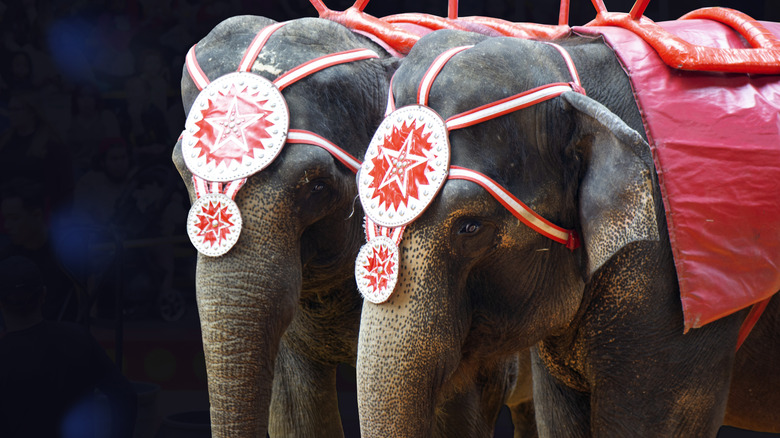The Heartbreaking Way Young Elephants Rescued From The Circus Act
Elephants were once a staple of circuses, with the most iconic traveling show, Ringling Bros. Barnum & Bailey Circus, having built its industry around the spectacle of the giant mammals in 1881. It took 135 years, until 2016, for the traveling show to retire animals from their performances, amid mounting pressure from animal rights groups and changing perceptions of animals used for entertainment in circus settings. While some exotic animals can be kept pets, such as these unexpected animals in Texas, the use of animals in circuses is banned in 27 countries and faces bans or heavy restrictions across the U.S.
The necessity of this switch and continued advocacy to stop animal use in circuses is exemplified by the heartbreaking stories of young elephants that have been rescued. Wildlife SOS in India focuses on the rehabilitation of various animals, including elephants used in circuses. When they welcome new elephants to one of their facilities, they find that they can suffer from severe emotional abuse and malnourishment, which results in multiple health issues. In an interview with Save Wildlife, Geeta Seshamani, co-founder of Wildlife SOS, highlighted the horrible mistreatment of elephants before coming to the refuge: "They are beaten, chained, and starved. When such rescued elephants enter their new homes at Wildlife SOS, they begin to display more natural behavior in a free and safe environment."
This act of attempting to force domestication for the entertainment of others can be an immeasurable act of cruelty towards the intelligent and kind elephant. Yet, as Seshamani highlights, the recovery of these young elephants, who had only known abuse at the hands of humans, continues to show their resilience after rescue.
The rehabilitation process for young elephants saved from the circus
Young elephants whose only experience in life is trying to earn money through circuses, as temple greeters, or begging, face particular difficulty when undergoing the rehabilitation process. In a new environment, the stress and trauma of a previous life start to manifest through repetitive behavior such as pacing, head bobbing, or aggressive pounding of the ground with their trunks.
Elephants brought to the Wildlife SOS refuge can struggle to adjust. As co-founder Geeta Seshamani stated in her interview with Save Wildlife, "Elephants in captivity forget what it means to be a wild elephant." For the team involved in the rehabilitation process, it can be a slow journey of helping them acclimate to their new home and finding activities that enrich each elephant the most, such as treats or walks, to encourage them to open up and accept their newfound freedom. In many cases, the rescued elephants form bonds with one another, helping them adapt to their new lifestyle. At the same time, some rescued elephants will always carry the scars of the past and require extra attention due to injuries sustained through neglect.
For those looking to help the many elephants still in need, Geeta Seshamani offers several recommendations, such as avoiding animal products and events that promote the captivity of wild animals, and supporting or donating to local NGOs and animal rights organizations. If you want more stories about the conservation of Earth's magnificent creatures, check out the heartwarming discovery researchers made about Yellowstone's bison after 120 years, or learn more about animal rehabilitation by reading about why cheetahs at zoos sometimes have support dogs.

